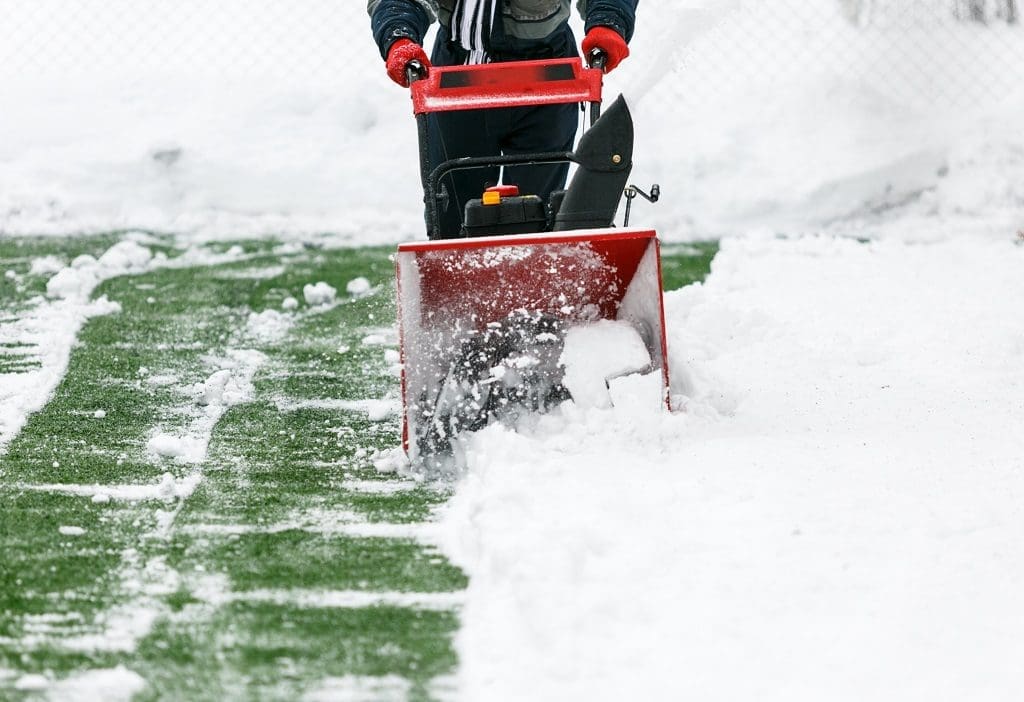Have you ever noticed patches of white on your lawn after the snow and ice have melted? That’s probably snow mold.
At Earth Development, we help businesses across the Midwest keep their outdoor property looking great, with healthy trees, shrubs, and lawn maintenance services. We know how to prevent snow mold on grass and how to get rid of it, and we’re always excited to share our knowledge.
Let’s take a look at snow mold disease and how you can prevent it.
Prevent Damage To Your Lawn From Snow Mold
We know you may have a lot of questions about snow mold, and we aim to answer them here.
First of all, it’s important to note that when dealt with quickly, snow mold doesn’t have to cause serious damage to your lawn. It can be fixed, and we regularly work with business owners across Milwaukee, Green Bay, and throughout Wisconsin to provide effective snow mold treatment.
Prevention and quick treatment help you maintain a healthy lawn.
What Is Snow Mold?
Snow mold is a kind of lawn disease that is caused by a fungus that looks a lot like snow. It typically occurs after snow melts, and as the temperature increases in the spring, the mold becomes more visible. Straw-colored spots of dead grass are also likely to appear on your lawn.
This mold occurs naturally, with the fungus spores living in the soil throughout the year and staying dormant during the extreme temperatures of winter.
Now, let’s consider the question “what does snow mold look like?”
Gray And Pink Snow Molds — What Is The Difference?
There are two kinds of mold to look out for: pink snow mold and gray snow mold.
The gray variety is a less damaging kind of mold, even though it might look like it has affected a large portion of your lawn. It appears in large patches of white/gray matter. It is most commonly found in regions of the United States that experience a large amount of snowfall.
Pink snow mold is more severe, penetrating deep into the roots of your grass. It is visibly pink and appears in roughly circular patches that may be interconnected. It survives – dormant – during the summer months and emerges after the winter when the snow has melted.
What Causes Snow Mold?
Snow mold appears on your lawn when snow – or even leaves – covers the grass for a long period during the winter. It is this cover that prevents the ground underneath from fully freezing, giving the fungus the perfect environment to survive and grow.
Typically snow mold doesn’t survive well in the summer months but remains dormant. When the weather gets cold but the ground is prevented from freezing, the fungus grows quickly.

What Kinds of Grass Does Snow Mold Affect?
Snow mold can easily cause damage to any cool-season turfs, which is one of the most common kinds of grass for property owners in the Midwest. As long as the grass is covered with snow for a long enough period, the fungus has an opportunity to grow.
Some grasses are more affected than others, however, with bentgrass being more likely to succumb to the fungus in the winter. Kentucky bluegrass, which is one of the most common cool-season grasses, is affected, but typically less so than bentgrass.
How To Treat Snow Mold?
There are ways to treat snow mold. Our local landscaping and lawn care professionals at Earth Development are always your best bet for handling this kind of landscaping problem, but there are some tips you should remember too.
First, remember to mow the lawn as you would normally. Tall grass is a good breeding ground for this fungus.
Secondly, take a rake and gently rake over the affected circles, pulling away from the thatch and helping the area dry out.
Finally, wait and see if the mold goes away on its own, and if it doesn’t, try using a fungicide product on the grass to kill off the remnants of the fungus.
How to Prevent Snow Mold
Now you know how to treat snow mold, but what about preventing it?
The key here is not ensuring that the spores don’t live in your soil, as that’s hard to prevent. Instead, there are steps you can take to avoid creating an environment where the fungus likes to grow.
Some of our top tips include:
- Dethatching your lawn: Removing thick layers of thatch from your lawn keeps air circulating and keeps the soil more exposed, preventing the build-up of fungus.
- Don’t allow leaves to pile up: Leaving thick layers of leaves on top of your lawn has the same effect as snow laying on your lawn for weeks at a time.
- Ease up on the nitrogen: Nitrogen-rich fertilizer is great for your lawn, but using too much of it late in the season feeds mold.
- Don’t allow snow to pile up: When you clear snow away from your driveways and walkways, don’t leave piles of snow on the lawn as this helps create the perfect environment for fungus to grow.
- Use fungicide: Fungicide can be used when all other measures don’t work, helping prevent the build-up of fungus in the first place.

Leave It To The Experts
Hopefully, this gives you an overview of what causes snow mold and how to treat snow mold – but we know how time-consuming managing and maintaining your lawn throughout the year can be.
To find out more about our professional lawn care services for businesses throughout the Midwest and for a free quote, call Earth Development today!
